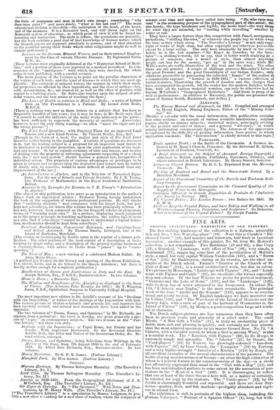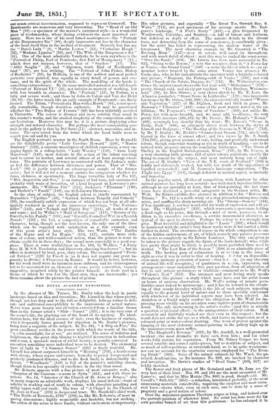FINE ARTS.
BRITISH INSTITUTION: EXHIBITION OF OLD PiCTIMES.
The first striking landscape of the collection is a Rubens, admirably rich and free, "The Watering-place" (16). Near this is Claude's "En- chanted Castle" (18), half massive and timeworn, half fresh in luxuriant decoration : another example of this painter, No. 90, from Mr. Holford's collection, is not remarkable. Two liobbimas (49 and 83), a fine Cuyp (53), a Ruysdael, "Landscape, with effect of Sun" (66), very simple, a Rembrandt (77), sug,g,es:ing some hint of the peculiarities of Martin's style, a small but very capital William Vandevelde (107), and a "Storm at Sea" (141) by Backhuysen, daring in its abandon, are the chief ex- amples of the Dutch school. Panini's "Interior of the Church of St. Paul at Rome" (124), is a sound architectural work, but dim in colour. Two pictures by Houseman, "Landscape with Figures" (84), and "Land- scape with Figures and Cattle" (99), are excellent—the former especially deep and solemn. Of the four WiLsons we prefer for poetical sentiment, " Genzano and the Lake of Nemi " (139), and the "Landscape" (128), with its deep bay of water advanced to the foreground. In colour No. 133, "L'Ariccia, near Naples," is the most remarkable. The principal work of the four, "Apollo and the Seasons" (122), appears to us conven- tional and poorly treated. Of English landscapes we have moreover one by Collins (119), and "The War-boats of the Island of Otaheite and the Society Isle; with a view of part of the harbour of Oaamaneno in the Island of Ulietea " (126), by Hodges, a good composition large and truth- ful in character.
The Dutch subject-pictures are less numerous than they have often been in previous years, and generally of a select order. The small Miens, "A Man with a Violin" (31), is truly an enchanting piece of finish, more soft and pleasing in quality, and certainly not less minute, than the most admired specimens by his master Gerard Dow. No. 73, "A Cabaret, with a Cavalier seated, to whom a Girl is serving Wine," is also a beautiful work. The "Exterior, with Figures" (69), by De Hooge, is extremely simple and agreeable. The "Interior" (27) by Ostade, the " Card-players " (63) by Teniers, the glowingly-coloured "Inn-door, with Figures " (67) by Isaac Ostade, the " Trumpeter " (79) by Terburg, and a very highly-wrought "Interior of a Kitchen" (110) by Zurgh, are all excellent examples of the several characteristics of the painters. The feeble cloying meretriciousness of Grouse—an artist the high estimation of whom is a painful feature in the connoisseurship of the day—is a shade less offensively expressed than usual in the "Girl with a Dug" (25), and has been individualized perforce to some extent by the necessities of por- traiture in the " Head of a Girl" (109). It is discouragina to reflect that one at least of the three Greuzes here will as a matter of certainty, be selected for copy by the students. The "Cattle-piece" (33) by Du Jardin is charmingly beautiful and reposeful : and there are four Sny- derses—poultry, fruit, and fish markets—prodigally abundant and vigor- ous in animal form.
Tim exhibition is rich in portraits of the highest 'class, including the glorious Velasquez, " Portrait of a Spanish Officer" (4), long, but with.- -out marsh critical discrimination, supposed to represent Cromwell. The Rembrandts are numerous and very interesting. The "Head of an Old Man" (19)--a specimen of the master's extremest style-is a 'wonderful piece of workmanship, whose daring evidences the most practised cer- tainty. Here too is one of his most famed masterpieces-the "Portrait of the Burgomaster Six" (89), deeply impressive not less in the character of the head itself than in the method of treatment. Scarcely less fine are the "Dutch Lady" (9), "Martin Looten " (13), "Catherine Hoogh " (52), "'Madame Lypsius" (80), and "The Wife of the Burgomaster Six" (91). One of the most admirable Vandycks to be seen anywhere is the "Portrait of Philip, Earl of Pembroke, first Earl of Montgomery" (3.5) ; which does not surpass, however, that of " Snyders " (43). The "Abbe Scaglia " (6), and "Algernon, tenth Earl of Northumber- land " (87), are less striking. The "Portrait of John Fisher, Bishop of Rochester" (95), by Holbein, is one of the noblest and most perfect portraits ever painted, true equally in every detail of person and cos- tume, and in the spirit of the whole. The modelling of the har.ds is something extraordinary. By the same unrivalled actualist is a full-length "Portrait of Edward VI." (22), not inferior in mastery of working, but with less breadth in character. The " Portrait " (55), by Porbus, is a lofty and severe work ; and those by John de Calear and Van der Heist (59, 82)-the latter much like an early example of Rembrandt-are finely treated. The Titian, "Portrait of a Man with a Hawk" (64), is not speci- ally remarkable, though doubtless authentic. It may be questioned whether the "Two Dukes of Ferrara" (60) has been rightfully ascribed to Tintoretto. The colour is dimmer and more retiring than usual in this - master's works, and the studied simplicity of the composition adds to our hesitation. However this may be, it is a picture displaying sober strength and natural character. But perhaps the most commanding por- trait in the gallery is that by Del Saito (71)-abstract, masculine, and in- tense. The eyes raised from the letter which the hand holds seem to search you out 'arid fix you.
The English portraits muster in the South Room. Here by Reynolds are the delightfully pretty "Lady Caroline Howard" (118), "Master Bunbury "-(123), a supreme masterpiece of childish expression, a very en- gaging figure in a riding-habit, "Lady Worsley " (138), "Anne Lady Ilarewood" (142), most delicate in the action of the infant reaching back to caress its mother, and several others of at least average excel- lence. The portraits of Lawrence as contrasted with Sir Joshua's make us feel the difference between cleverness and power. That of "Mrs. Lock" (98) is justly reputed an advantageous sample of the former artist; but it will not for a moment sustain the comparison whether for force, richness, or spontaneity. The huge towerlike lady of No. 137, " Mrs. Ang,erstein and-Son," is An instance of bad taste, not unconnected probably with want of invention, of dkind frequent in Lawrence's pre- sentments. His "William Pitt" (111), Jackson's " Flaxman" (130), and Harlow's " Fuseli" (140), are well-known likenesses. In the class of subject, the English school is chiefly represented by Reynolds's " Lrgolino " (56), "Garrick between Tragedy and Comedy" (70), the excellently subtile expression of which has not been at all ade- quately rendered in any of the numerous engravings, "The Fortune- teller" (113), and "Nymph and Piping Boy" (114), all works of note and name ; and by Wilkie's "Maid of Saragossa" (115), "Return of the Guerilla to his Family" (134), and "Guerilla Council of War in a Spanish Posada" (136) ; the last, a composition of remarkable animation and character, being, though not the best known, the only one of the three which can be regarded with satisfaction as a fair example even of this great artist's later style. The two Wests, "The Battles of the Boyne and of La Hogue" (112, 117), contain more rich- ness of colour, and well-considered action, than the painter is wont to obtain credit for in these days ; the second more especially is a good sea- piece. There is some truthfulness in No. 102, by Webber, "A Party from H. M. S.S. Resolution and Discovery, shooting Sea-horses" ; but its effect is destroyed by hard, poor, slaty colour. The so-catalogued "Poeti- cal Subject" (120) by Fuseli is (as it does not require any great in- genuity to divine) a Francesca da Rimini. It would be better, however, for the work itself were its intention more dubious, and its extravagances left to be accounted for as elements of some poetic conception, vaguely suggestive, imagined solely by the • painter himself. As made part in a theme of which he was but the Must; ator, they are inexcusable ; yet there remains about the picture the fact of genius.



























 Previous page
Previous page